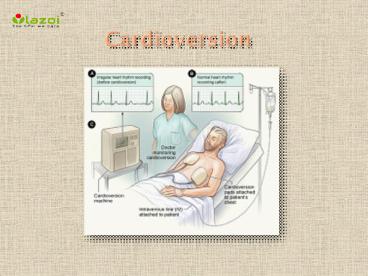Cardioversion - PowerPoint PPT Presentation
Title:
Cardioversion
Description:
Cardioversion is a medical process that restores a normal heart rhythm in people with certain types of abnormal heartbeats (arrhythmias). – PowerPoint PPT presentation
Number of Views:209
Title: Cardioversion
1
Cardioversion
2
Cardioversion
- What is Cardioversion?
- Cardioversion is a medical practice that brings
back a normal heart rhythm in people with certain
types of abnormal heartbeats (arrhythmias). - Cardioversion is usually done by sending electric
shocks to your heart through electrodes placed on
your chest. It's also possible to do
cardioversion with medications. - For what Cardioversion is used?
- Cardioversion is usually used to treat people who
have atrial fibrillation or atrial flutter. These
conditions occur when the electrical signals that
normally make your heart beat at a regular rate
don't travel properly through the upper chambers
of your heart. - Cardioversion is performed when your heart is
beating ineffectively. It's usually scheduled in
advance but is sometimes also done in emergency
situations.
3
Treatment
- What is the Treatment cost of Cardioversion in
India? - The Cardioversion usually costs from 3-4 lakh
rupees in India. - Which specialty of doctor to be consulted for
Cardioversion in India? - Cardiologist
4
FAQ's
- 1. What are the risks related with
Cardioversion? - Complications of electric cardioversion are
uncommon, and doctors can take steps to reduce
your risk. Major risks of cardioversion include - Dislodged blood clotsSome people who have
irregular heartbeats have blood clots in their
hearts. Electric cardioversion can cause these
blood clots to move to other parts of your body.
This can cause life-threatening complications,
such as a stroke or a blood clot traveling to
your lungs (pulmonary embolism). - Abnormal heart rhythmIn rare cases, some people
who undergo cardioversion end up with other heart
rhythm problems during or after their procedure.
This is a rare complication.
5
FAQ's
Continue
- If it happens, it usually shows up only minutes
after your procedure, so your doctor can give you
medications or additional shocks to correct the
problem. - Skin burnsRarely, some people have minor burns on
their skin where their electrodes were placed. - 2. What are the steps to be taken during
Cardioversion? - A nurse or technician will place several large
patches called electrodes on your chest. The
electrodes will be connected to a cardioversion
machine (defibrillator) using wires. - The defibrillator will record your heart rhythm
throughout the procedure and will deliver shocks
to your heart to restore a normal heart rhythm.
6
FAQ's
Continue
- This machine can also correct your heart's
rhythm if it beats too slowly after
cardioversion. - Before the shocks are delivered, a nurse or
technician will insert an intravenous (IV) line
in your arm. The IV line is used to give you
medications that will make you sleep during the
cardioversion so that you won't feel any pain
from the shocks. Your doctor may also use the IV
line to give you additional medications that can
help restore your heart rhythm. - 3. What are the steps to be taken after the
Cardioversion? - Electric cardioversion is done on an outpatient
basis, meaning you can go home the same day your
procedure is done. You'll spend an hour or so in
a recovery room being closely monitored for
complications.
7
FAQ's
Continue
- Because you'll be asleep for the cardioversion,
your awareness of your surroundings may be
affected afterward. You'll need someone to drive
you home, and your ability to make decisions may
be affected for several hours after
cardioversion. - Even if no clots were found in your heart before
cardioversion, you'll take blood-thinning
medications for at least several weeks after your
procedure to prevent new clots from forming. - 4. What happens after I get home?
- Before you leave, you'll get instructions about
what to do at home. For a few days after
electrical cardioversion, the skin on your chest
and back may be irritated where the paddles were
placed. Ask your doctor about creams or medicines
that can help.
8
CONNECT WITH US
- Logon to
- www.lazoi.com
- Like us on Facebook
- https//www.facebook.com/LazoiTheLife
- Follow us on Twitter
- https//www.twitter.com/lazoithelife
- Follow us on Pinterest
- https//www.in.pinterest.com/lazoithelife































